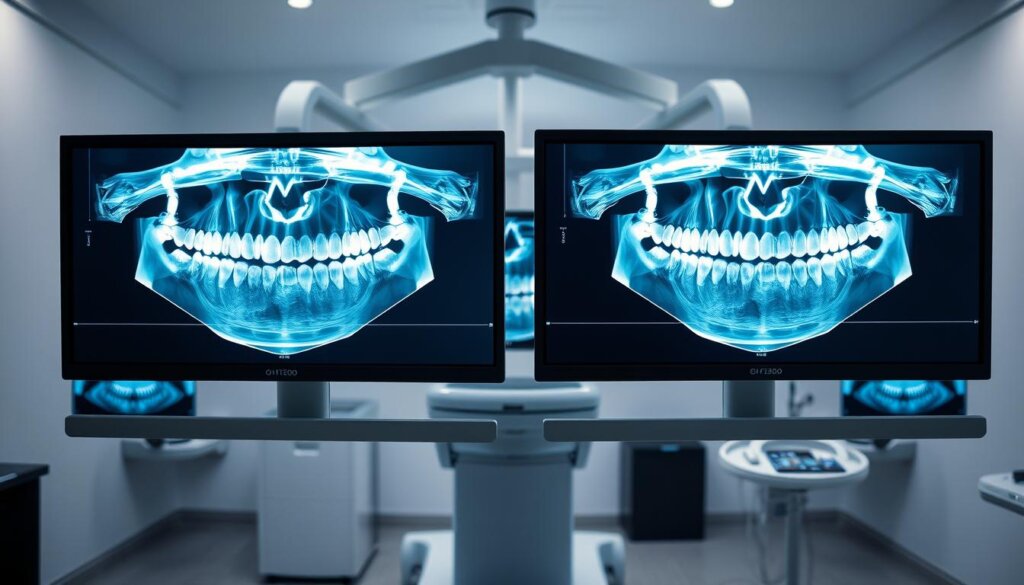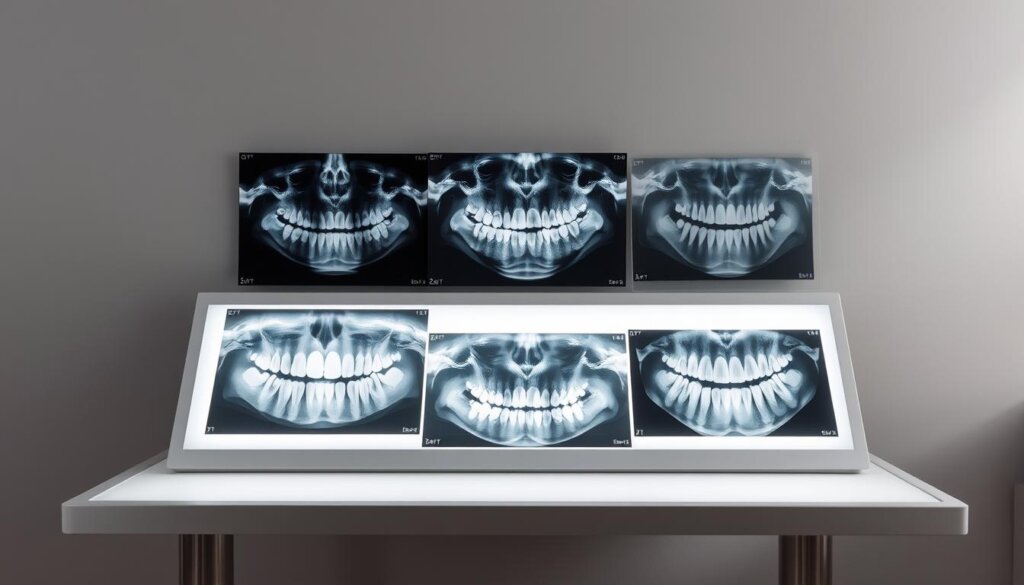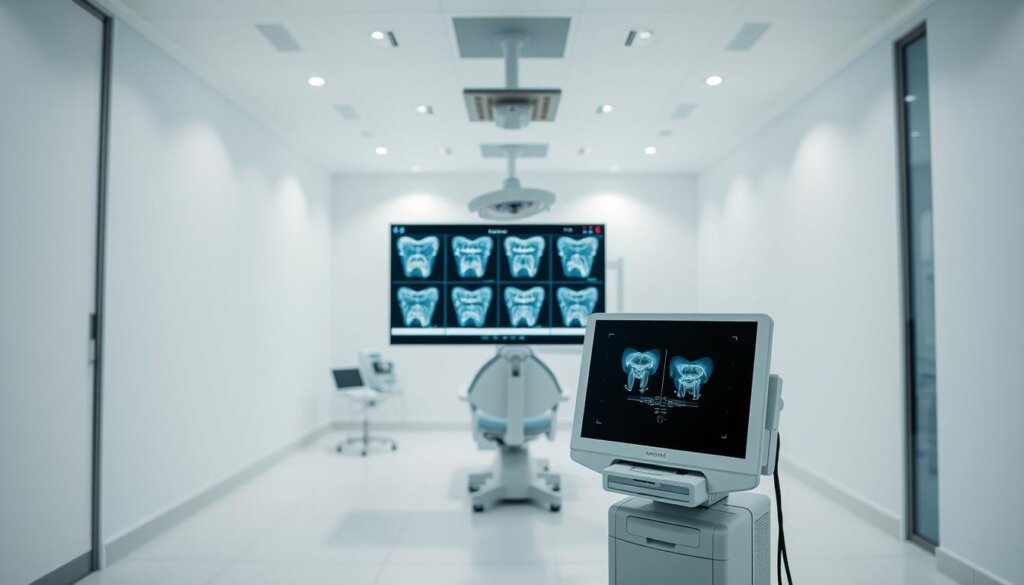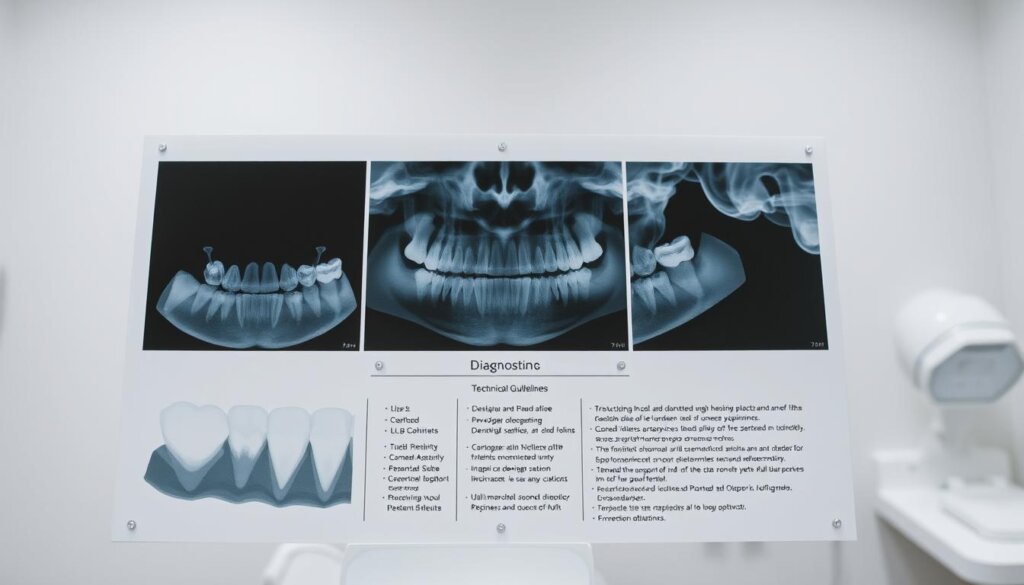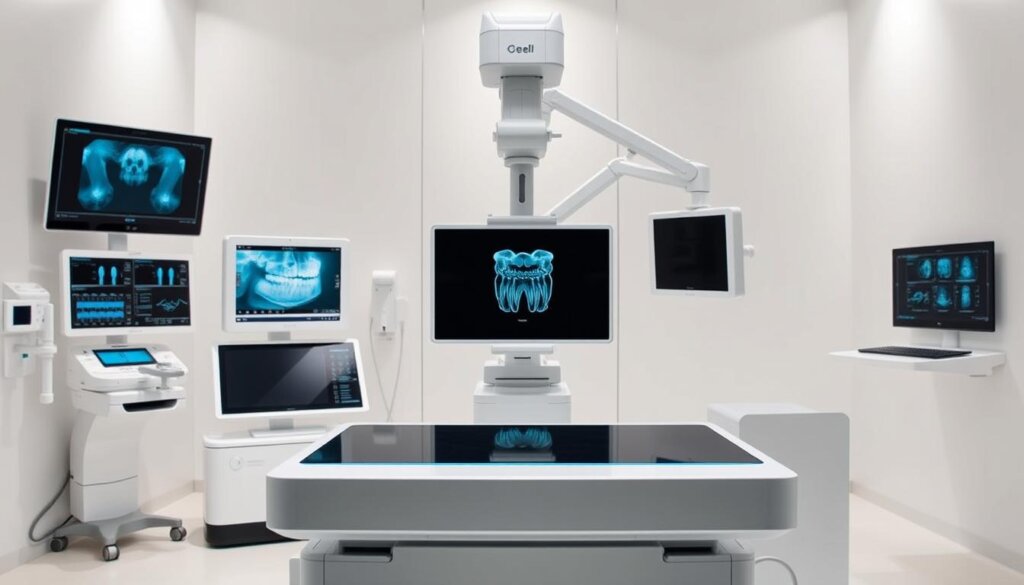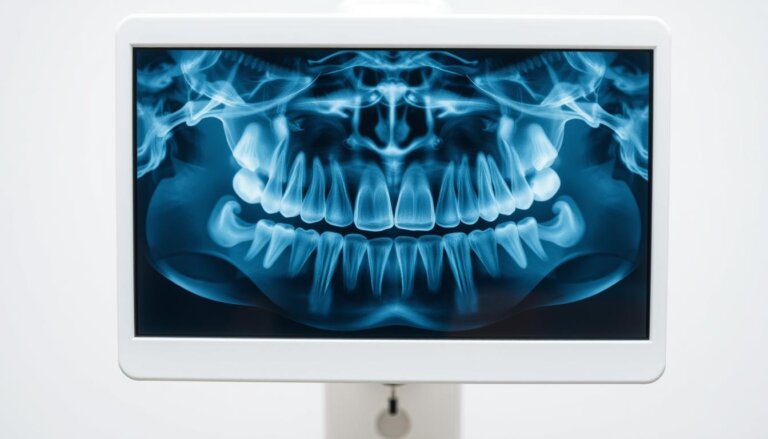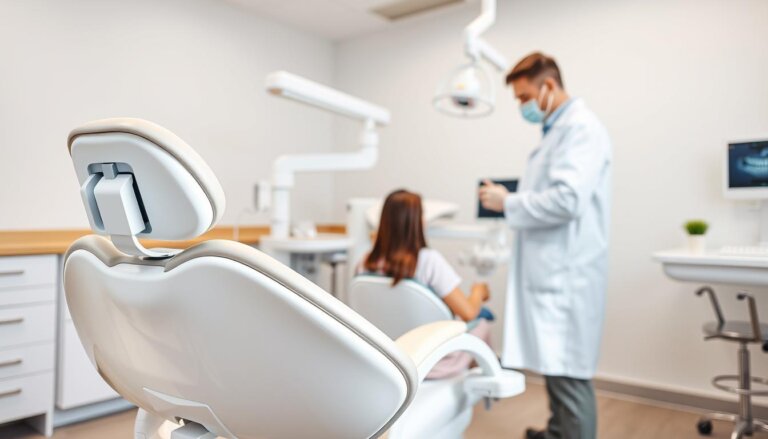Will I Get X-rays at Every Dental Check-up?
Not every dental check-up will include X-rays. While these images are crucial for a deep check of your oral health, they’re not needed for everyone every time. Dental X-rays show us what we can’t see with just our eyes, like hidden problems under our gums. Doctors decide when to use them, taking care to limit your exposure to X-rays.
This part will cover if you’ll see an X-ray machine at your next dental visit. Dental X-rays are super important for finding hidden tooth decay, bone loss, and other issues. But, the need for them varies by your age, oral health, and past dental experiences. First-time patients usually get a detailed X-ray to set a starting point for tracking their oral health over time.
Key Takeaways
- Dental X-rays are not a mandatory component of every dental examination but are critical when prescribed.
- Individual needs, oral health, and dental history heavily influence the frequency of X-rays in preventive dentistry.
- Initial X-rays often serve as vital baselines for new patients in monitoring oral health progression.
- Dental X-rays are a fundamental element of comprehensive oral health screening, identifying issues invisible to the naked eye.
- Understanding the role of X-rays can help patients appreciate their use as a tailored aspect of dental hygiene care.
Understanding Dental X-rays
Dental X-rays, which include dental radiographs and dental imaging, are key in today’s dentistry. They give important details not seen in a regular exam. These images use different types of radiation. This lets them show the makeup of teeth, bones, and nearby soft tissues in various ways.
What Are Dental X-rays?
Dental X-rays are a type of dental imaging that uses a little radiation. They capture images inside your teeth and gums. This helps spot issues like cavities, tooth decay, and blocked teeth. They use both old-school and digital X-rays. These are vital for seeing the full picture of your dental health.
Types of Dental X-rays
There are different X-rays for different dental needs:
- Intraoral X-rays: These are the most common and provide clear images. They include periapical, bitewing, and occlusal types.
- Extraoral X-rays: These focus on the jaw and skull for a bigger picture. Types include panoramic, cephalometric, and Cone Beam CT (CBCT).
Benefits of Dental X-rays
The perks of dental radiographs are many:
- Diagnosis: They catch early signs of decay, gum issues, and teeth alignment unseen in exams.
- Intervention: Catching these early means less complex treatments later.
- Planning: They provide exact details for planning treatments like implants and braces.
Using digital X-rays in regular dental care boosts diagnosis accuracy. It also cuts down radiation risk compared to old methods. This marks a big step forward in keeping patients safe and comfortable during dental checks.
The Purpose of Dental Check-ups
The main goal of a routine dental visit is to fix current problems and prevent new ones. These visits are key for keeping your mouth healthy for a long time.
Knowing what happens at these check-ups can make patients more comfortable. We’ll explain the usual steps of a visit and their importance.
Importance of Regular Dental Visits
Preventive dentistry pushes for regular check-ups to stop dental diseases early. These visits can catch problems like cavities and gum disease early on. So, going to these appointments is a big step for keeping your teeth healthy always.
What Happens During a Dental Check-up?
A dental check-up starts with a full look at your mouth. The dentist checks your teeth, gums, and overall mouth health. Sometimes, X-rays are needed to get a closer look at what’s happening under your gums.
After checking your mouth, you get your teeth professionally cleaned. This cleaning gets rid of plaque and tartar that can lead to gum diseases. Lastly, you’ll talk about how to take care of your teeth at home. The dentist will give advice tailored to you on how to keep your mouth healthy.
Frequency of Dental X-rays
Knowing when to get dental X-rays is key to good oral health. The need for an X-ray at a checkup depends on many things. These include a person’s past dental health, their age, and current mouth issues. So, you don’t always need an X-ray when you see the dentist. This shows why a personalized plan for checking your mouth’s health is vital.
Dentists decide if you need X-rays by looking at your individual situation. New patients often need a full set of X-rays to start with. But, if you’re a returning patient, you might just need X-rays from time to time. This helps keep track of any changes or problems with your teeth.
| Patient Type | X-ray Schedule | Reason for X-rays |
|---|---|---|
| New Patients | Initial and comprehensive | To establish a dental health baseline |
| Existing Patients with Known Issues | Every 6-18 months | Monitoring ongoing issues or treatments |
| Low Risk Adults | Every 24-36 months | General maintenance and preventive care |
This method allows for a plan that fits each person’s needs in X-ray frequency. It balances careful observation with reducing too much X-ray exposure. By looking at risk factors and the current dental condition, dentists make an X-ray plan. This plan is good for both figuring out problems and planning how to fix them.
Factors That Influence X-ray Frequency
Dental X-rays are decided by many factors, important for keeping your teeth healthy. These factors help watch closely and spot any risk of tooth decay early.
Age and Dental Health
- Young people with changing teeth or adults who’ve had a lot of dental work might need X-rays more often. This helps track how well the treatments are working.
- Older folks might not need X-rays as much unless they have new dental issues needing a close look.
Previous Dental Issues
- If you’ve had lots of cavities or serious gum problems before, you might need X-rays often. This helps catch any new problems early.
- Having things like fillings and crowns also affects how often you need X-rays. It lets dentists check how these treatments are holding up.
Dentist’s Professional Judgment
Dentists look at what they find in your exam, along with your health history and symptoms, to decide on X-rays. They do this to best manage and track your risk of tooth decay.
Dentists follow the ALARA principle. This means they try to use the least amount of radiation needed to get the info that will help keep your teeth healthy.
Personalized care matters a lot. A dentist’s expert decision on X-ray frequency helps balance safety and the need for effective dental care.
Understanding these factors shows why dentists tailor X-ray use. It’s all about making sure dental care fits your specific health needs and conditions.
Risks and Benefits of Dental X-rays
Dental X-rays are vital for preventive dentistry. They help spot issues that can’t be seen during a normal exam. However, it’s key for both doctors and patients to weigh the risks and benefits.
Dental X-ray safety measures are very strict, especially about radiation exposure. These steps help keep everyone safe during the process.
X-rays mean low-level radiation exposure. But, thanks to new technologies and shielding, the danger is now lower. Also, the good that comes from using X-rays is huge. They help make very accurate treatment plans and find problems early.
- Potential Risks Involved:
- Radiation is minimal and well-managed.
- Rules are extra careful for kids and pregnant women.
- Diagnostic Benefits:
- They catch tooth decay, infections, and bite issues early.
- They’re key for planning things like dental implants or braces.
To wrap up, dental X-rays are a perfect example of how modern medicine uses preventive dentistry. It’s all about making sure the good outweighs any bad, for healthier teeth.
Different Types of X-rays
Today’s dental offices use many kinds of dental x-rays. These help dentists understand your oral health better. Knowing about different dental x-rays helps dentists find and fix problems accurately.
| Type | Purpose | Detail Captured |
|---|---|---|
| Bitewing X-rays | Used to identify decay between teeth and changes in bone density caused by gum disease. | Captures the crowns of the posterior teeth and the height of the alveolar bone. |
| Periapical X-rays | Focuses on the entire tooth, from the crown to beyond the root where the tooth anchors into the jaw. | Each radiograph shows a detailed view of a few teeth in one area. |
| Panoramic X-rays | Provides a broad overview of the entire mouth, including teeth, upper and lower jaws, sinuses, and other structures. | Enables assessment of emerging teeth, impacted teeth, and tumor growth. |
Dentists pick from these x-ray types based on what they need to know. For example, Bitewing X-rays are good for regular visits to spot early decay. Periapical X-rays provide a close-up look at the tooth’s root for specific issues.
Panoramic X-rays help a lot with orthodontic plans and checking wisdom teeth. Each type of dental x-ray is key for finding the best treatment in caring for teeth.
How Dentists Decide on X-ray Usage
Preventive dentistry includes using dental X-rays wisely. Dentists follow dental X-ray guidelines and look at patient history. This makes sure each X-ray serves a purpose. It helps in providing good care without extra exposure.
Guidelines from groups like the ADA are key. They set rules dentists follow to keep things safe and consistent. The ADA and FDA have rules on when and how often to use X-rays. This keeps radiation low but still helps diagnose issues.
Guidelines from Dental Associations
The ADA updates its X-ray guidelines based on new science. These guidelines tell dentists how to use X-rays safely. They talk about:
- Lowest radiation doses
- Best times for routine X-rays, based on age and dental risk
- Using protective gear and new digital X-rays to lower radiation
Patient History Considerations
Looking at a patient’s health history is important. It helps dentists decide if X-rays are needed by:
- Checking for past dental problems or diseases
- Looking at gum disease or decay history
- Reviewing past dental work like fillings and crowns
Dentists use past health info and check current oral health to decide on X-rays.
Following dental X-ray guidelines and knowing patient history helps dentists. They use X-rays wisely in preventive dentistry. This means better care and safety for patients.
New Technologies Impacting X-ray Use
The dental care world is always getting better, thanks to new technologies for dental X-rays. Dental X-ray innovation and digital radiography are leading the change.
Digital radiography is a big step forward in dental examination advancements. It uses less radiation, which many patients worry about. It also makes images clearer for better diagnosis and treatment planning.
- Enhanced Image Quality: Digital X-rays offer clearer, more detailed views. This helps dentists find problems more accurately.
- Immediate Availability: Digital images show up right away, with no wait time. This makes check-ups quicker.
- Environmentally Friendly: Digital X-rays don’t need film or chemicals. This makes them better for the planet.
New steps in dental X-ray innovation are crucial for better diagnosis and keeping patients safe and comfortable. Moving to digital radiography shows dentists’ commitment to better care and reducing risks.
Alternatives to Traditional X-rays
In preventive dentistry, traditional X-rays are key for checking oral health. But new technologies offer other dental imaging alternatives. These options give clear diagnostics with less radiation exposure. They help keep dental care up-to-date while reducing risk.
Visual exams are a top choice that don’t use X-rays. Dentists closely look at the mouth to spot decay, gum disease, and more. Intraoral cameras are crucial here. They show detailed images of the mouth, helping dentists see what we can’t with just our eyes.
There are also advanced imaging methods. 3D imaging lets dentists see teeth and jaws in three dimensions. This is super helpful for planning big dental work, like orthodontics or implants. Another cool technique uses lasers for optical scanning. This makes exact digital models of teeth.
| Technique | Applications | Benefits |
|---|---|---|
| Intraoral Cameras | Early decay detection, education, documentation | Minimal invasiveness, high-resolution images, real-time analysis |
| 3D Imaging | Implant planning, orthodontic assessments, diagnostics | Comprehensive views, precise measurements, improved treatment planning |
| Optical Scanning | Crown fittings, restorative work, custom appliances | Non-invasive, accurate models, enhanced patient comfort |
These imaging options are improving preventive dentistry. They’re becoming key parts of dental care. They focus on keeping patients safe and comfortable, while still providing detailed check-ups.
Preparing for a Dental X-ray
Getting a dental X-ray involves cutting-edge tech and strict safety steps. People often worry about radiation. Yet, today’s methods make the process very safe, keeping dental health at the forefront. Here’s a rundown of what to expect for a dental X-ray.
What to Expect
First off, a dentist or tech will walk you through the X-ray steps. They stress the need for clear pictures to check oral health. You’ll go to a room with the X-ray machine. Depending on the X-ray type, you might need to prepare in specific ways. For example, routine check-ups often use intraoral X-rays. They need small sensors placed in the mouth. This part is quick, wrapping up in just minutes.
Safety Measures Taken
Dental pros use protection like lead aprons and thyroid collars to cut radiation risks. Also, today’s X-ray gear targets a tiny mouth area, lowering radiation. This method greatly drops radiation exposure.
Dentists follow the ALARA rule, meaning ‘As Low As Reasonably Achievable’, for using radiation. They update their radiation handling skills often, keeping the clinic safe.
Knowing these actions can ease fears of dental X-rays, showing how important they are. With the latest tech and strict safety steps, dental offices make sure health and cleanliness are priority in the X-ray process.
Frequently Asked Questions About X-rays
Many people wonder if X-rays are needed at every dental visit. The truth is, it depends on your specific dental needs and the dentist’s practice. It’s also key to know you have the right to make choices during your dental examination.
Do all dentists use X-rays? Not always. Dentists use X-rays to help diagnose problems and plan treatments. But they only do this when it’s really needed, based on your oral health and dental issues.
Can I refuse X-rays? Yes, you can say no to X-rays. But it’s important to understand what that decision means. Without X-rays, your dentist might not be as accurate in diagnosing or treating you. You should talk about your worries with your dentist to make the best choice for your health and comfort.
| Question | Rights and Autonomy | Usage in Dental Practice |
|---|---|---|
| Are dental X-rays mandatory? | Patients can refuse, but informed discussions with the dentist are recommended. | Used based on individual health needs and clinical guidelines. |
| What if I choose to refuse X-rays? | Patients have the right to refuse; however, they should understand the potential impact on diagnostic accuracy. | Dental examinations may proceed without X-rays, potentially affecting treatment outcomes. |
Cost Considerations for Dental X-rays
It’s important to understand the costs of dental X-rays for both patients and providers. Prices change based on the type of X-ray, where the dental office is, and if the patient has insurance. We’ll look at average costs and how dental benefits and oral health financing affect getting these key diagnostic tools.
Many worry about the cost of dental X-rays. Managing these costs helps make sure money issues don’t stop people from getting the oral care they need. We will cover typical costs and how insurance plays a role.
Average Costs Associated
The price for dental X-rays usually falls within a certain range. But, the exact cost can change based on the diagnosis needs. Bitewing X-rays tend to be cheaper, while panoramic X-rays cost more.
Insurance Coverage for X-rays
Most dental insurance plans cover X-rays as part of regular dental visits, either partly or fully. Patients should check their dental benefits to see how much of the X-ray cost is covered. This affects how affordable dental X-rays are and the decisions patients make about their dental health.
Knowing the usual costs of dental X-rays and insurance coverage helps patients plan their dental expenses better. Also, looking into oral health financing options can help manage costs. This ensures everyone can get the dental care they need without financial worry.
In closing, understanding dental X-ray affordability, dental benefits, and oral health financing helps with financial planning. It also helps in making wise health decisions. Patients are encouraged to talk to their insurance providers for detailed coverage information.
Impact of X-ray Frequency on Overall Dental Health
How often dentists use X-rays plays a big role in keeping our teeth healthy. It helps them keep an eye on our dental health and make things better for us. They can spot problems early on by using X-rays wisely, leading to better care for our teeth over time.
In preventing dental problems, it’s all about stopping issues before they start. Using dental X-rays regularly helps with this. They let dentists catch and deal with problems early. This can stop bigger issues from happening later.
Key Benefits of Regular Dental X-rays:
- Spotting problems early, before they get worse.
- Making better treatment plans by understanding oral health better.
- Checking that areas treated before stay healthy.
Let’s look at how X-ray frequency, keeping an eye on dental health, and better dental results are linked. Consider these points on preventive dental care:
| Aspect | Benefit |
|---|---|
| Early Detection | Leads to less invasive treatments and reduces the likelihood of emergencies. |
| Periodic Monitoring | Helps track the success of treatments and maintenance of dental health. |
| Risk Assessment | Identifies areas at high risk, guiding preventative measures. |
Making X-rays part of regular dental visits greatly helps in preventing problems. It means dentists can act early, not just fix issues. This way, they help keep not only our teeth but our whole body healthier.
State Regulations Regarding Dental X-rays
In the dental care world, rules about state dental laws, dental radiograph regulations, and compliance in dentistry are important. They keep patients safe and make sure dental practices use X-rays correctly. They also help professionals maintain quality care.
Different states have different rules for dental X-rays. Each state’s dental board sets standards that all dentists must follow. This ensures patient care is consistent and safe.
Compliance Standards in Dentistry
Following state rules for dental X-rays protects patients and helps dental offices avoid legal issues. Dentists need to keep up with rule changes. This way, their practices stay within the law.
| State | Registration Requirements | Radiation Safety Protocols |
|---|---|---|
| California | Mandatory equipment registration | An annual inspection and compliance certification |
| New York | Operator certification required | Regular updates of safety procedures |
| Texas | Registrations must be renewed biennially | Strict adherence to state-mandated safety courses |
| Florida | X-ray machines must be registered with the state health department | Compliance audits every two years |
Informed Consent for X-ray Procedures
In the world of dentistry, dental X-ray consent is super important. It’s not just a simple form. It’s a big part of teaching patients and doing things right. It means telling patients about X-rays and why they need them. This helps them understand how it affects their oral health screening and treatment plans.
This step makes sure the dentist and the patient trust each other. It shows how important it is for patients to help make decisions about their oral health. We’ll talk about why patient consent is key and how dentists explain the X-ray process.
Importance of Patient Consent
Getting a patient’s okay before doing X-rays is important for a few reasons:
- It respects the patient’s freedom and their right to choose about their health care.
- It builds trust and comfort, making the dental visit better for everyone.
- It keeps the practice safe legally by following medical ethics and rules.
Understanding the X-ray Process
Dentists have a big job in patient education when it comes to X-rays. They need to clearly explain:
- Why the X-ray is needed and how it finds problems that can’t be seen in a regular check-up.
- Any risks and how they keep them low, like using lead aprons.
- How X-rays can help keep or improve oral health, now and later.
With these talks, patients can say yes to X-rays, knowing all about their benefits and safety. This is part of taking good care of their oral health.
Conclusion: The Role of X-rays in Dental Care
X-rays are key in modern dentistry for diagnosing and planning treatment. They help find problems that we can’t see just by looking. Using X-rays wisely is part of keeping dental care tailored to each person.
They’re not needed at every check-up, though. But when used right, X-rays can find hidden issues early. This makes sure everyone gets the right care for their teeth.
Final Thoughts on X-ray Usage
Dental X-rays aren’t the same for everyone. How often you need them depends on your age, dental history, and if you have mouth problems. When used right, X-rays are a powerful tool for keeping teeth healthy.
Knowing this, patients and dentists understand their value. They help catch and treat dental issues early on.
Encouragement for Open Communication with Your Dentist
Talking with your dentist about X-rays is crucial. Ask questions and share your worries. Knowing about X-rays helps you take part in your dental care.
This conversation builds trust between you and your dentist. It makes sure X-ray decisions are good for you. In the end, this teamwork helps keep your mouth and body healthy.

